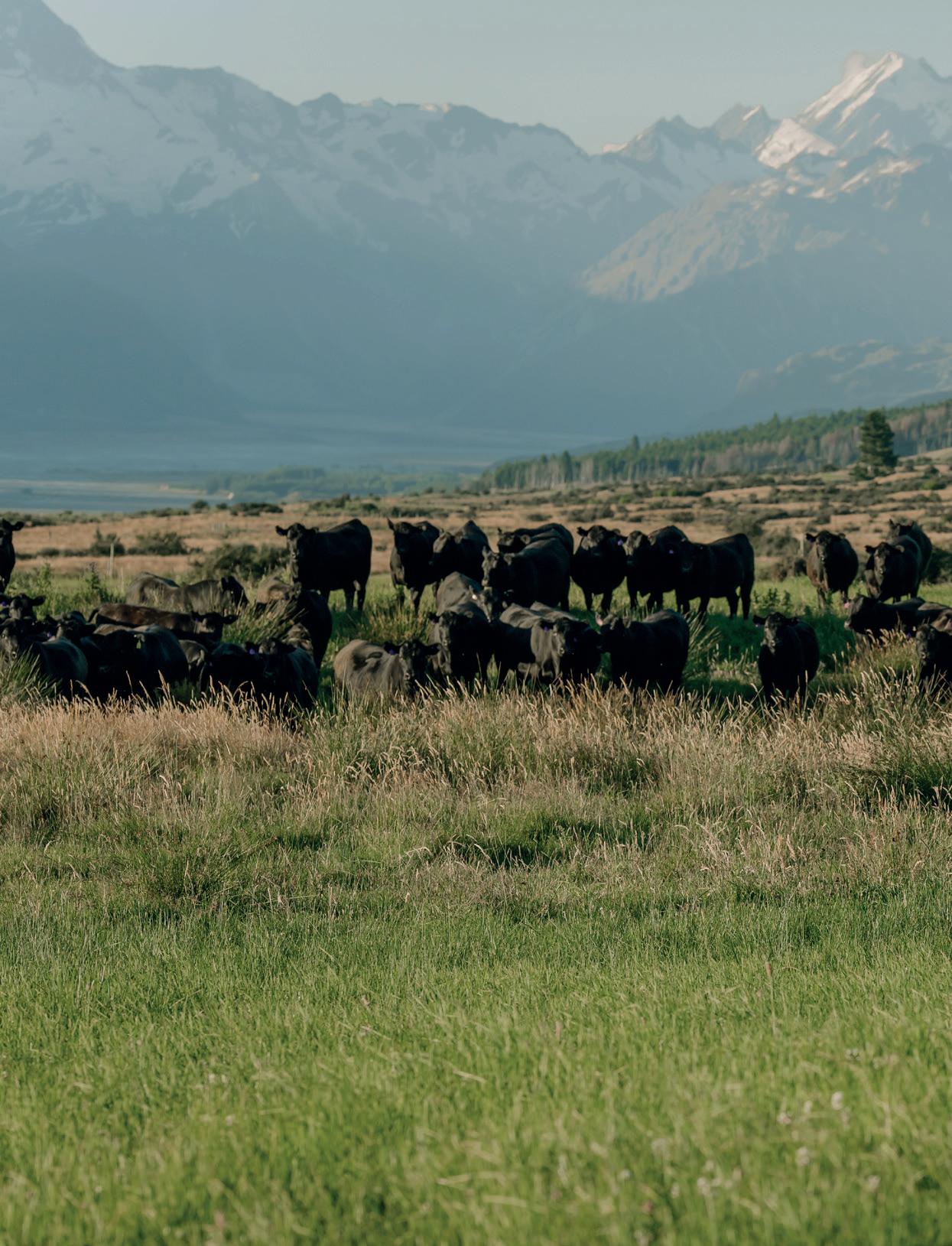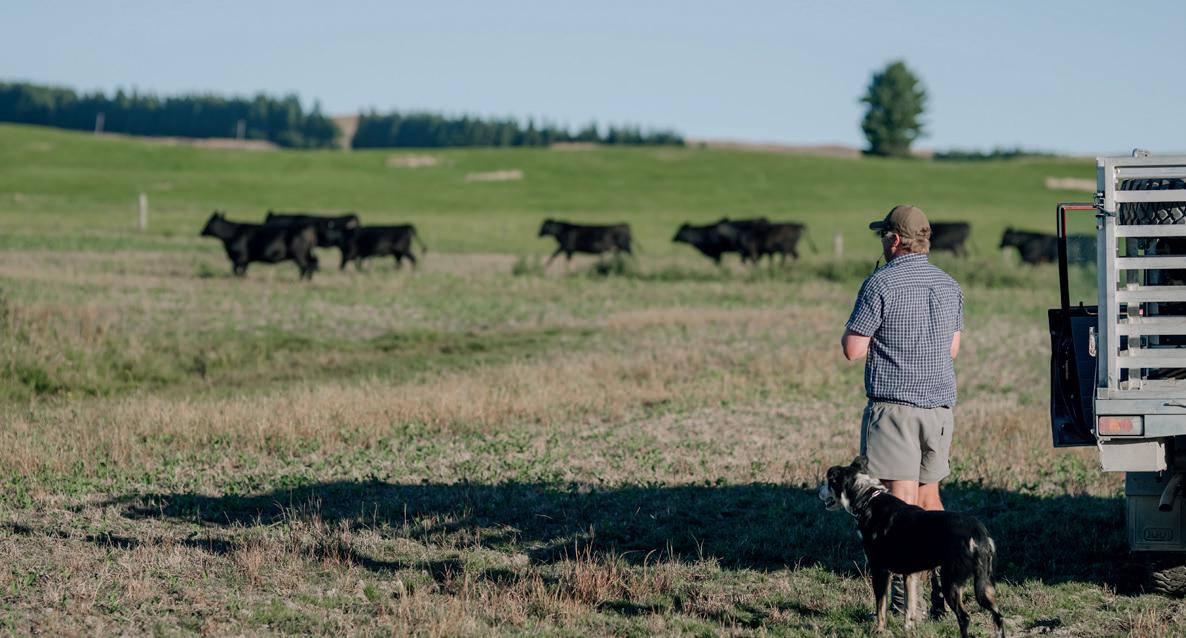
10 minute read
From the ground up
COMMON GROUND
| Julia and Hamish Mackenzie farm against a backdrop of the Southern Alps and Aoraki/Mt Cook.
COMMON GROUND
Two farms, two islands. For Braemar Station in the Mackenzie hill country and Tokaanu Station on the North Island Volcanic Plateau, the benefits of sound agronomy advice are just as significant.

Sustainable farming starts from the ground up at Braemar Station. The iconic Mackenzie hill-country farm features a spectacular landscape with views of Aoraki/Mt Cook, the Southern Alps and Lake Pukaki. But beauty comes at a price, with hot dry summers and cold biting winters of sub-zero temperatures. Managing and planning for these extremes is key to Hamish and Julia Mackenzie’s farming programme.

Hamish Mackenzie
Pasture renewal and winter feed is a focus of their farming operation, with close to 100ha of new grass planted this season. Hamish is always on the lookout for the best stock feed combinations. It’s a work in progress, he says, to meet the changing environmental needs and extremes of the property. Central to that work over the last 15 years has been Farmlands’ South Canterbury and North Otago Agronomist Dave Schrader. “We have a good relationship with the guys at Farmlands,” Hamish says. “They know the farm and how it ticks and I’m not afraid to try different grasses.” Braemar Station, originally 27,000ha, was bought in 1969 by a partnership that included Hamish’s parents, Duncan and Carol Mackenzie. The Mackenzies took on sole ownership in 1975. Farming was hard throughout the 1970s and 1980s. Deer were introduced to the property in 1981. Hamish began shepherding straight from school, first in North Canterbury and then Australia, before returning to the family farm with wife Julia in 2000. Tenure review, signed off in 2014, significantly changed the scale of farming, with 17,000ha of Braemar Station retired to the Crown under Department of Conservation authority. The arrangement allowed the family to freehold an additional 2,100ha, giving them a total farm size of 4,100ha. The rolling property runs around 5,000 Perendale ewes, 370 Angus cows and 900 deer – velveting 140 stags, plus replacements. Braemar Station sits on the edge of a nor’west rainbelt and gets about 875mm annual rainfall. It features deep brown fertile soils. Hamish has an 8 to 10-year rotating pasture renewal programme. The winter feed programme is based on Kestrel kale, a high-quality feed for young sheep and cattle. The ground is then planted in a permanent pasture or a 1 to 2-year Italian ryegrass to allow for any weed burden management and fertiliser applications. Hamish has used a lot of Aber, a high-sugar grass that has performed well. This year he is trialling Tyson perennial ryegrass, aiming for grass growth as early in the season as possible. “Tyson is hardy and with an early spring growth and a strong yearround yield we are hoping it will perform from early spring and then through for silage cuts, with around 2,500 tonnes of grass silage grown in the summer and fed out in the winter,” he says. Hamish is also trialling Barena Brome and has directdrilled 38ha of an elevated and drier area on the property. “Brome suits the drier climate and has a good root system and is apparently palatable even when it goes to seed. It is ideal for drier country so we will be interested to see how the deer go on that and also the 18ha of Prospect AR1, an all-year-round ryegrass.” Hamish has also had success with Raphno, a hybrid kale/ radish cross with a high forage yield. “We started with Raphno about 5 years ago and our lambs yield well off it over the summer. Raphno is a deep-rooted plant so does well in the summer dry and we can get multiple grazings off it. We plant around 30ha and between the Raphno and grasses try to have lambs leaving the farm at an average carcass weight of 18kg.” Hamish says getting the pasture options right is crucial, with all grass mixes including red and white clover. “We try and choose pastures and brassicas to suit what we do and you don’t know how something new will work until you try it.”
| Hamish Mackenzie discusses the Te Manahuna Aoraki project with its manager, Simone Smits.
COMMON CAUSE

Braemar Station is part of Te Manahuna Aoraki conservation project. Launched in November 2018, this aims to enhance biodiversity across 310,000ha in the upper Mackenzie Basin and Aoraki/Mount Cook National Park. Te Manahuna Aoraki focuses on restoring the iconic natural landscapes of the area, including the braided river systems and alpine habitats, and its endangered species. These include kea, tuke/rock wren and scree weta in the alpine zone and ngutuparore/wrybill, robust grasshopper and the world’s rarest wading bird, kakī/black stilt. Te Manahuna Aoraki includes private and public land. Iwi, high-country runholders, government departments, philanthropists, councils and the community are working together towards a shared vision for this special environment. Hamish says the strength of the project is in that collaboration. “It is an awesome example of community collaboration for environmental outcomes,” he says. “Julia is on the board, and we have already seen significant protection progress. We are working with absolute professionals in their sector; they are very specialist and passionate and are making real traction. There is a huge breeding programme of native birds and plants, and we are definitely seeing results.”

| Julia Mackenzie with a kakī chick at DOC’s Kakī Recovery Programme aviary near Twizel. Photo: Claudia Mischler

BRAEMAR Station has opened up the natural beauty of its surroundings with four different self-contained accommodation options. Among the guests are riders at the end of their first day on the Alps 2 Ocean Cycle Trail, which runs through the station and on to Twizel and Omarama before heading down the Waitaki Valley to Oamaru. Hamish says a tonne of food goes through the farm kitchen. The cyclists get an evening meal, breakfast and a packed lunch for the day’s journey to their next stop on the 6-day trail. Braemar’s move into accommodation has proven popular. No wonder, with Lake Pukaki offering trout fishing and boating and the station’s tracks proving ideal for mountain biking and walking. The nearby Round Hill, Mt Dobson and Ōhau skifields also make Braemar Station an ideal winter stay.

| Cyclists on the Alps 2 Ocean Cycle Trail. Photo: Hedgehog House.

John Haywood
For John Haywood, farming south of Lake Taupo on the North Island Volcanic Plateau, the imperatives differ but the benefits of sound agronomy advice are just as significant. Winter crops and a regrassing programme have been key to his move from conventional farming to a more intensive style. “Technology, seeds, pastures and crops are improving all the time. It is a great way to boost productivity while also supporting the environment. We farm under a nitrogen cap with a nitrogen discharge limit so getting stock off earlier is also better for the environment.” John has been leasing Tokaanu Station, 525ha of flat and terraced country, in Turangi for around 36 years. It is north-facing and predominantly pumice so prone to dry summers. His son Josh runs John’s 200ha block in Taihape and seeing Josh’s results around winter crops and new pastures triggered John’s change.
John describes his agronomy programme as simple but successful. Lambs and cattle are now finished earlier and therefore are off the property earlier and are weighing in at heavier weights than in the past. He runs 2,250 Romney ewes, 700 hoggets and 200 Angus cows. A third of the farm has a contour that allows it to be cropped. He puts the success of the switch down to a combination of his willingness to try something new and sound agronomic advice from Farmlands and plant breeding and research company Barenbrug. “Both companies are interested in the success of my business, continually building on a long-term relationship, always keen to come and have a look and offer great advice,” he says. His association with Farmlands Agronomist Brian Richards goes back 10 years. Together they worked out when the pinch times were for feed demand and seasonal issues and addressed these. An area of Shogun, a hybrid ryegrass, was established to intensify John's cattle-finishing programme. “It grows like crazy but it does need to be managed to get the most out of it.” John says the winter brassica and Shogun work well together, achieving significant liveweight gains. “The Shogun has gone so well we planted another 30ha this spring.” Through excellent pasture management the Shogun has persisted for 5 years. The initial area is coming to an end and will be replaced with Forge, Barenbrug’s newest hybrid ryegrass, through a cropping programme. Rohan, Tabu and Governor have also been used to improve the overall sheep and beef systems. John finishes all the calves that are not kept as replacements. “We have a pick and take the best off system and are selling rising 2-year steers at 300kg carcass weight. Before we changed our feeding programme these would have left the farm in around November at about 26 months; now they are heading off-farm 4 to 5 months earlier at 22 months.” John winters his stock on swede and kale, which usually come out in September. The land is planted in a leafy turnip that is mob stocked with lambs from January. This formula has been used for the last 3 years, resulting in lambs going straight off the crop and to the works in February and March at a 23-24kg carcass weight. “So as well as 3-4kg weight increase, by mob stocking there are 60-70 lambs per hectare, leaving the rest of the farm to be shut up for mating. “It’s a win-win – the stock are feeding well, they are off the property earlier and at better weights,” John says.

THE EXPERTS
Agronomy is the study of how to grow crops effectively, profitably and while caring for our natural resources and environment. For Sam Lucas, Farmlands’ Head of Agronomy and Farm Systems, it comes down to planning, matching feed supply with demand and having advisors you can trust.
Planning: Doing this early is critical. Good planning helps ensure the correct preparation and planting times to help set crops up well. Preparation may start 12-24 months out with consideration of soil pH, nutrient levels and problem weeds. Feed: Matching the supply and demand of critical feed is only part of the equation. Economic and environmental factors such as climate, soils, aspect and rainfall all affect the agronomy decisions for forage type and preparation. Advisors: Partnering with trusted advisors who are interested in the success of your business is critical.

To The Core
Leadership and Governance Development Programme


Farmlands Co-operative, Silver Fern Farms Co-operative and LIC are pleased to welcome applications for our award-winning rural governance and leadership programme – To The Core. This unique programme has been designed for Farmlands, Silver Fern Farms and LIC shareholders and gives participants an opportunity to learn more about governance in our co-operatives, as well as develop the skills needed to operate at board level. Ideally you will be on the land and already have involvement with community groups and clubs.
Where: Farmlands Co-operative Support Office, 535 Wairakei Road, Burnside, Christchurch 8053 and Peppers Clearwater When: Tuesday 7th − Thursday 9th June 2022 Programme fee: $795 incl GST — Includes accommodation and all meals during the course.
The programme features an outstanding line up of top speakers, as well as opportunities to discuss issues impacting boards. • A perspective on agribusiness co-operative boards: strategy and structure • How to navigate boards through risk and market disruption Shareholders of the three co-operatives are invited to apply for positions – numbers are limited. If you have any questions about To The Core, please contact Clark Taylor (Shareholder Relations Manager, Silver Fern Farms) on clark.taylor@silverfernfarms.com or 029 914 5060.






